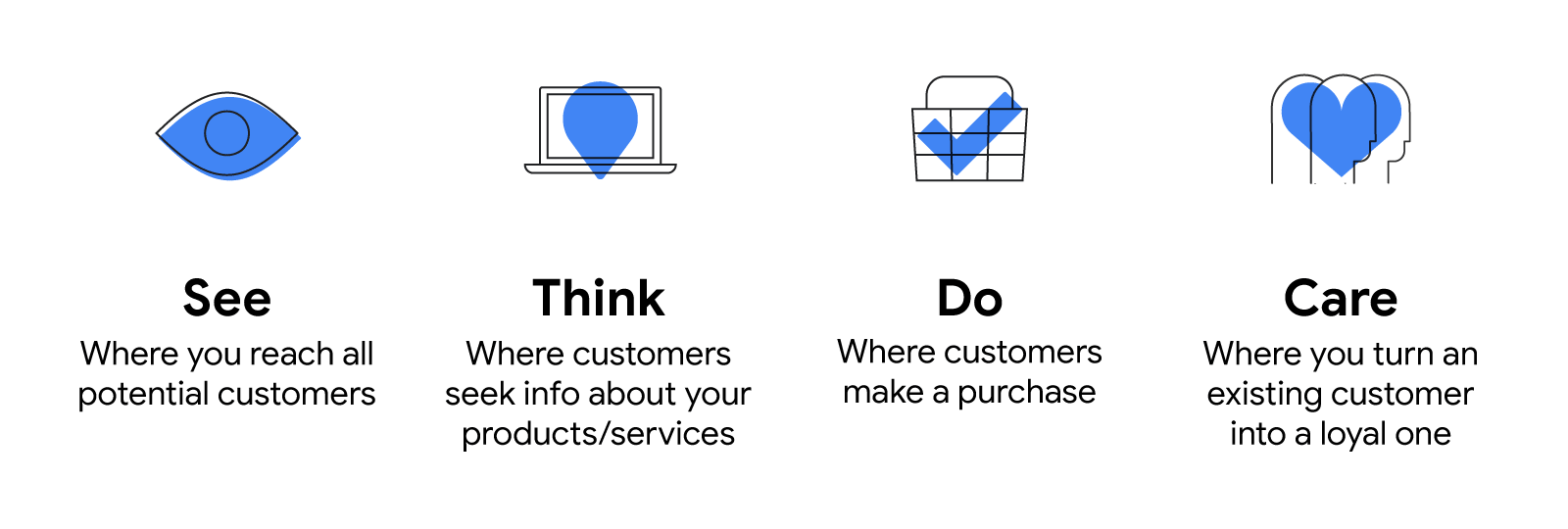Vajda Éva is a CEO and Co-founder of iWebMa Analytical Marketing agency talking about the digital journey the teams set off on together with Nissan.
When the pandemic hit, the automotive industry found itself in a jam. Its showrooms — where customers could test drive and fall in love with their new vehicles — were closed and fewer people were exposed to out-of-home advertising.
But together with our client, Nissan, we were determined to bring that legendary new car smell to screens across Hungary, Slovakia, and Czechia. We did it with the See-Think-Do-Care (SDTC) framework — an effective tool for creating an online marketing plan — to pivot its once offline strategy into one that’s aligned with new consumer behaviours.
See-Think-Do-Care framework

Capturing low hanging fruit
We set up a comprehensive campaign structure focusing on ‘low-hanging fruit’, which for us meant maximising reach and conversions. The campaigns spanned across Hungary, Slovakia, and the Czech Republic, initially focusing on the ‘Think’ and ‘Do’ phases of the framework.
During the ‘Think’ stage, customers are seeking out information about a brand’s products and services. So our goal was to maximise the number of engaged visitors to Nissan’s website.
We reached people exploring car purchasing options with branded keywords like ‘Nissan SUVs’, ‘Nissan Crossovers’, and ‘Nissan SUV models’. We also engaged people who were more generally searching online for an SUV or crossover car. We then directed them towards a place that could lead to a micro conversion — like downloading a car brochure and pricelist, or getting them to compare crossover models.
In the ‘Do’ phase, customers are ready to make a purchase. Our goal was to maximise conversions with remarketing campaigns which focused on audiences who had previously visited the Nissan website.
We started by identifying who performed some sort of micro conversion. We then directed them with Display and YouTube TrueView for Action campaigns to macro conversions, such as applying for a test drive or requesting an online presentation.
To make the process more measurable and provide a better customer experience, Nissan set up its own customer relationship centre — Hello Nissan. We supported ramping up the operations by using an automated tool on the website to direct visitors there seamlessly.
“Automotive business is not e-commerce (yet). Shopping still ends in the dealership, but there’s a huge gap in the customer journey between the brand website and the salesmen — where brands have no control and not even real visibility”, says Gergely Kisfalvi, chief operating officer at Nissan Grand Automotive Central Europe. “Hello Nissan was created to bridge this gap and to get in direct contact with the customer earlier during the purchase process. Monitoring Hello Nissan results helps in assessing the efficacy of digital communication as well,” he adds.
More dealer interactions

The results were astounding. Dealer interactions shot up by 678% in Hungary, 1171% in Slovakia, and 1223% in Czech Republic, when compared to previous traditional campaigns.
Seeing the digital potential
This year we took the next step in this new digital strategy for Nissan by expanding the intended audience with brand awareness campaigns for the SUV model: the Nissan Juke.
iWebMa facilitated a detailed planning process that was the foundation of the pilot project. This holistic approach was a critical part of the success.
To reach the ‘See’ audience — those farthest away from the buying decision and who may not even know the brand or its products yet — Nissan’s goal was to engage with users who weren’t actively looking for that specific SUV model, or any other cars for that matter, but could be potential customers in the future.
The teams launched YouTube campaigns over a period of four weeks. Online video fit Nissan’s marketing goals best, as it allowed them to reach the widest group of potential ‘See’ customers across all devices; mobile, TV, tablet, and desktop.
The YouTube campaigns ran for one month and dramatically increased consumer interest in the new Juke model. Compared to the previous period, ad clicks increased by 30% in Hungary, 137.4% in Slovakia, and 118.2% in Czechia. Conversions went up 66.4% in Hungary, 147.6% in Slovakia, and 162.3% in Czechia.
“Back in 2020, iWebMa facilitated a detailed planning process that was the foundation of the pilot project. This holistic approach was a critical part of the success,” concludes Kisfalvi.
But this is just the beginning. For the second half of this year we’ve planned another brand awareness campaign of a new car model, the Nissan Qashqai, with a similar campaign structure since the combination worked so well for the Juke.







